Scaling and Clustering in Southern California Earthquake Sequences: Insights from Percolation Theory
Abstract
1. Introduction
2. Materials and Methods
2.1. Data
2.2. Earthquake Complex Network and Percolation Model
3. Results
3.1. Percolation Process in Earthquake Complex Network
3.2. Validation Using the Shuffled Model
- Shuffled Model 1: Completely random locations; simulated inter-event intervals; randomly assigned magnitudes.Construct a fully randomized model that preserves none of the original sequence’s characteristics.
- Shuffled Model 2: Locations based on probability distribution; simulated inter-event intervals; randomly assigned magnitudes.Construct a only keep the fractal characteristics of the original sequence model.
- Shuffled Model 3: Locations based on probability distribution; real earthquake inter-event intervals; randomly assigned magnitudes.Construct a model that preserves both the fractal characteristics and the event time intervals of the original sequence.
- Shuffled Model 4: Real earthquake locations; simulated inter-event intervals; randomly assigned magnitudes.Construct a model that strictly preserves the earthquake events locations.
- Shuffled Model 5: Real earthquake locations; real earthquake inter-event intervals; randomly assigned magnitudes.Construct a model that strictly preserves both the earthquake events locations and events time intervals.
3.3. Examination of Finite-Size Effects
4. Conclusions
Author Contributions
Funding
Data Availability Statement
Conflicts of Interest
References
- Gutenberg, B.; Richter, C.F. Frequency of earthquakes in California. Bull. Seismol. Soc. Am. 1944, 34, 185–188. [Google Scholar]
- Utsu, T. A statistical study on the occurrence of aftershocks. Geophys. Mag. 1961, 30, 521–605. [Google Scholar]
- Utsu, T. Aftershocks and earthquake statistics (4): Analyses of the distribution of earthquakes in magnitude, time and space with special consideration to clustering characteristics of earthquake occurrence (2). J. Fac. Sci. Hokkaido Univ. Ser. Geophys. 1972, 4, 1–42. [Google Scholar]
- Bak, P.; Christensen, K.; Danon, L.; Scanlon, T. Unified scaling law for earthquakes. Phys. Rev. Lett. 2002, 88, 178501. [Google Scholar] [CrossRef]
- Corral, A. Local distributions and rate fluctuations in a unified scaling law for earthquakes. Phys. Rev. E 2003, 68, 035102. [Google Scholar]
- Corral, Á. Long-term clustering, scaling, and universality in the temporal occurrence of earthquakes. Phys. Rev. Lett. 2004, 92, 108501. [Google Scholar] [PubMed]
- Zhang, Y.; Fan, J.; Marzocchi, W.; Shapira, A.; Hofstetter, R.; Havlin, S.; Ashkenazy, Y. Scaling laws in earthquake memory for interevent times and distances. Phys. Rev. Res. 2020, 2, 013264. [Google Scholar] [CrossRef]
- Zhang, Y.; Zhou, D.; Fan, J.; Marzocchi, W.; Ashkenazy, Y.; Havlin, S. Improved earthquake aftershocks forecasting model based on long-term memory. New J. Phys. 2021, 23, 042001. [Google Scholar]
- Corral, Á. Dependence of earthquake recurrence times and independence of magnitudes on seismicity history. Tectonophysics 2006, 424, 177–193. [Google Scholar]
- Lippiello, E.; Godano, C.; De Arcangelis, L. Dynamical scaling in branching models for seismicity. Phys. Rev. Lett. 2007, 98, 098501. [Google Scholar]
- Lippiello, E.; Godano, C.; de Arcangelis, L. The earthquake magnitude is influenced by previous seismicity. Geophys. Res. Lett. 2012, 39, L05309. [Google Scholar] [CrossRef]
- Lippiello, E.; de Arcangelis, L.; Godano, C. Influence of time and space correlations on earthquake magnitude. Phys. Rev. Lett. 2008, 100, 038501. [Google Scholar]
- Xiong, Q.; Brudzinski, M.; Gossett, D.; Lin, Q.; Hampton, J. Seismic magnitude clustering is prevalent in field and laboratory catalogs. Nat. Commun. 2023, 14, 2056. [Google Scholar] [PubMed]
- Martin-Montoya, L.; Aranda-Camacho, N.; Quimbay, C. Long-range correlations and trends in Colombian seismic time series. Phys. A Stat. Mech. Its Appl. 2015, 421, 124–133. [Google Scholar]
- Telesca, L.; Lovallo, M.; Lapenna, V.; Macchiato, M. Long-range correlations in two-dimensional spatio-temporal seismic fluctuations. Phys. A Stat. Mech. Its Appl. 2007, 377, 279–284. [Google Scholar]
- Ferreira, D.; Ribeiro, J.; Papa, A.; Menezes, R. Towards evidence of long-range correlations in shallow seismic activities. Europhys. Lett. 2018, 121, 58003. [Google Scholar]
- Zhang, Y.; Elbaz, M.; Havlin, S.; Ashkenazy, Y. Reduced seismic activity after mega earthquakes. Commun. Earth Environ. 2024, 5, 297. [Google Scholar]
- Jones, L.M.; Molnar, P. Some characteristics of foreshocks and their possible relationship to earthquake prediction and premonitory slip on faults. J. Geophys. Res. Solid Earth 1979, 84, 3596–3608. [Google Scholar]
- Ross, Z.E.; Cochran, E.S. Evidence for latent crustal fluid injection transients in Southern California from long-duration earthquake swarms. Geophys. Res. Lett. 2021, 48, e2021GL092465. [Google Scholar] [CrossRef]
- Zaliapin, I.; Ben-Zion, Y. A global classification and characterization of earthquake clusters. Geophys. J. Int. 2016, 207, 608–634. [Google Scholar]
- Mignan, A. The debate on the prognostic value of earthquake foreshocks: A meta-analysis. Sci. Rep. 2014, 4, 4099. [Google Scholar] [CrossRef] [PubMed]
- Ben-Zion, Y. Collective behavior of earthquakes and faults: Continuum-discrete transitions, progressive evolutionary changes, and different dynamic regimes. Rev. Geophys. 2008, 46, RG4006. [Google Scholar] [CrossRef]
- Reasenberg, P.A.; Simpson, R.W. Response of regional seismicity to the static stress change produced by the Loma Prieta earthquake. Science 1992, 255, 1687–1690. [Google Scholar] [CrossRef]
- Wyss, M.; Wiemer, S. Change in the probability for earthquakes in southern California due to the Landers magnitude 7.3 earthquake. Science 2000, 290, 1334–1338. [Google Scholar] [CrossRef]
- Lippiello, E.; de Arcangelis, L.; Godano, C. Role of static stress diffusion in the spatiotemporal organization of aftershocks. Phys. Rev. Lett. 2009, 103, 038501. [Google Scholar] [CrossRef] [PubMed]
- Tibi, R.; Wiens, D.A.; Inoue, H. Remote triggering of deep earthquakes in the 2002 Tonga sequences. Nature 2003, 424, 921–925. [Google Scholar] [CrossRef]
- Richards-Dinger, K.; Stein, R.S.; Toda, S. Decay of aftershock density with distance does not indicate triggering by dynamic stress. Nature 2010, 467, 583–586. [Google Scholar] [CrossRef] [PubMed]
- Brodsky, E.E.; van der Elst, N.J. The uses of dynamic earthquake triggering. Annu. Rev. Earth Planet. Sci. 2014, 42, 317–339. [Google Scholar] [CrossRef]
- Krishna Mohan, T.; Revathi, P. Earthquake correlations and networks: A comparative study. Phys. Rev. E—Stat. Nonlinear Soft Matter Phys. 2011, 83, 046109. [Google Scholar] [CrossRef]
- Baiesi, M.; Paczuski, M. Complex networks of earthquakes and aftershocks. Nonlinear Process. Geophys. 2005, 12, 1–11. [Google Scholar] [CrossRef]
- Baiesi, M.; Paczuski, M. Scale-free networks of earthquakes and aftershocks. Phys. Rev. E—Stat. Nonlinear Soft Matter Phys. 2004, 69, 066106. [Google Scholar]
- Abe, S.; Suzuki, N. Complex earthquake networks: Hierarchical organization and assortative mixing. Phys. Rev. E—Stat. Nonlinear Soft Matter Phys. 2006, 74, 026113. [Google Scholar] [CrossRef] [PubMed]
- Golden, K.; Ackley, S.; Lytle, V. The percolation phase transition in sea ice. Science 1998, 282, 2238–2241. [Google Scholar] [CrossRef] [PubMed]
- Ali Saberi, A. Percolation description of the global topography of earth and the moon. Phys. Rev. Lett. 2013, 110, 178501. [Google Scholar] [CrossRef] [PubMed]
- Fan, J.; Meng, J.; Saberi, A.A. Percolation framework of the Earth’s topography. Phys. Rev. E 2019, 99, 022304. [Google Scholar] [CrossRef]
- Lu, Z.; Yuan, N.; Fu, Z. Percolation Phase Transition of Surface Air Temperature Networks under Attacks of El Niño/La Niña. Sci. Rep. 2016, 6, 26779. [Google Scholar] [CrossRef]
- Meng, J.; Fan, J.; Ashkenazy, Y.; Havlin, S. Percolation framework to describe El Niño conditions. Chaos Interdiscip. J. Nonlinear Sci. 2017, 27, 035807. [Google Scholar] [CrossRef]
- Qiu, L.; Zhu, Y.; Song, D.; He, X.; Wang, W.; Liu, Y.; Xiao, Y.; Wei, M.; Yin, S.; Liu, Q. Study on the nonlinear characteristics of EMR and AE during coal splitting tests. Minerals 2022, 12, 108. [Google Scholar] [CrossRef]
- Dazhao, S.; Qiang, L.; Liming, Q.; Jianguo, Z.; Khan, M.; Yujie, P.; Yingjie, Z.; Man, W.; Minggong, G.; Taotao, H. Experimental study on resistivity evolution law and precursory signals in the damage process of gas-bearing coal. Fuel 2024, 362, 130798. [Google Scholar]
- Hauksson, E.; Yang, W.; Shearer, P.M. Waveform relocated earthquake catalog for southern California (1981 to June 2011). Bull. Seismol. Soc. Am. 2012, 102, 2239–2244. [Google Scholar]
- Zhuang, J.; Ogata, Y.; Wang, T. Data completeness of the Kumamoto earthquake sequence in the JMA catalog and its influence on the estimation of the ETAS parameters. Earth Planets Space 2017, 69, 1–12. [Google Scholar] [CrossRef]
- Zaliapin, I.; Ben-Zion, Y. Earthquake clusters in southern California I: Identification and stability. J. Geophys. Res. Solid Earth 2013, 118, 2847–2864. [Google Scholar] [CrossRef]
- Cohen, R.; Havlin, S. Complex Networks: Structure, Robustness and Function; Cambridge University Press: Cambridge, UK, 2010. [Google Scholar]
- Newman, M. Networks; Oxford University Press: Oxford, UK, 2018. [Google Scholar]
- Stauffer, D.; Aharony, A. Introduction to Percolation Theory; Taylor & Francis: Abingdon, UK, 2018. [Google Scholar]
- Nagler, J.; Levina, A.; Timme, M. Impact of single links in competitive percolation. Nat. Phys. 2011, 7, 265–270. [Google Scholar] [CrossRef]
- Fan, J.; Meng, J.; Liu, Y.; Saberi, A.A.; Kurths, J.; Nagler, J. Universal gap scaling in percolation. Nat. Phys. 2020, 16, 455–461. [Google Scholar] [CrossRef]
- Bollobás, B.; Riordan, O. Percolation; Cambridge University Press: Cambridge, UK, 2006. [Google Scholar]
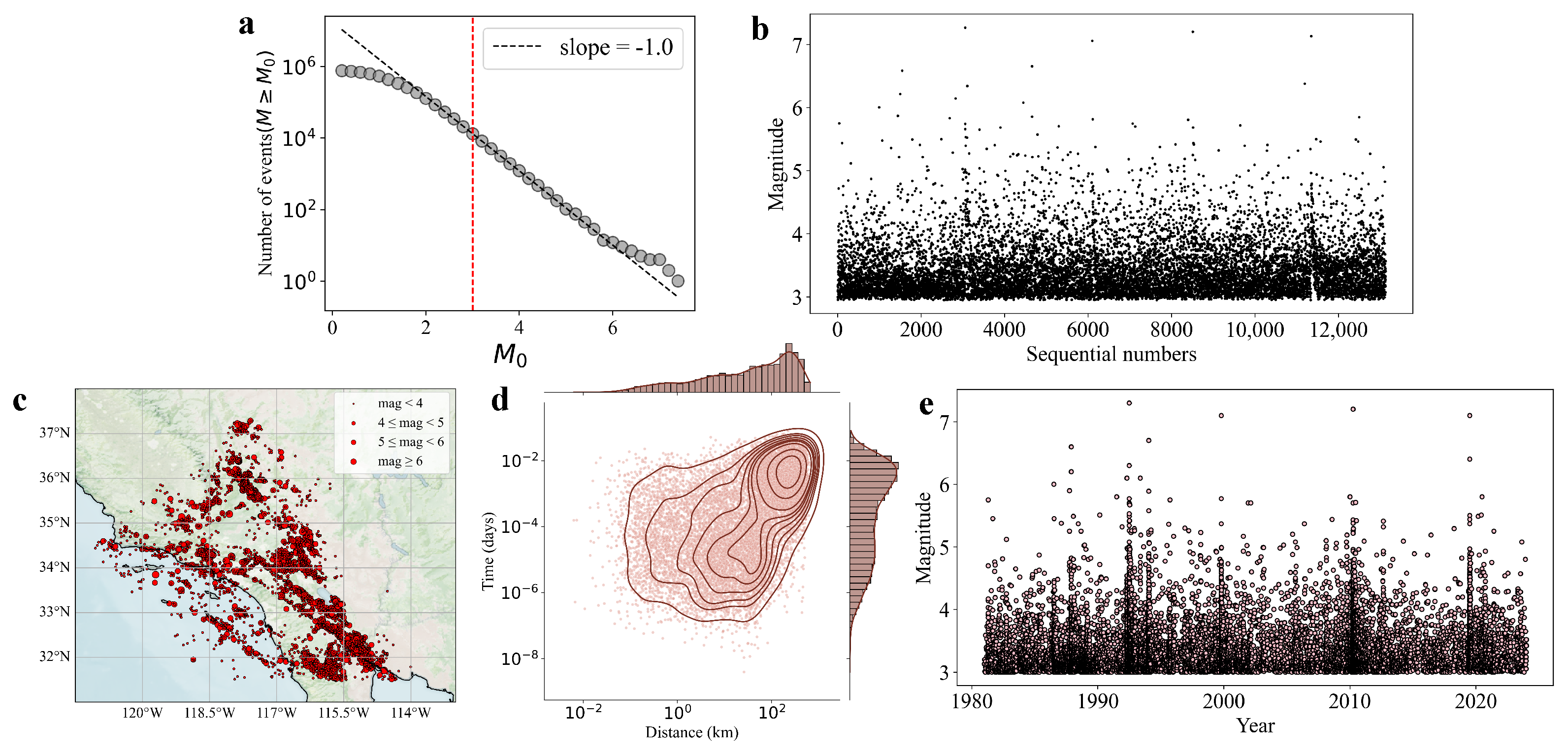
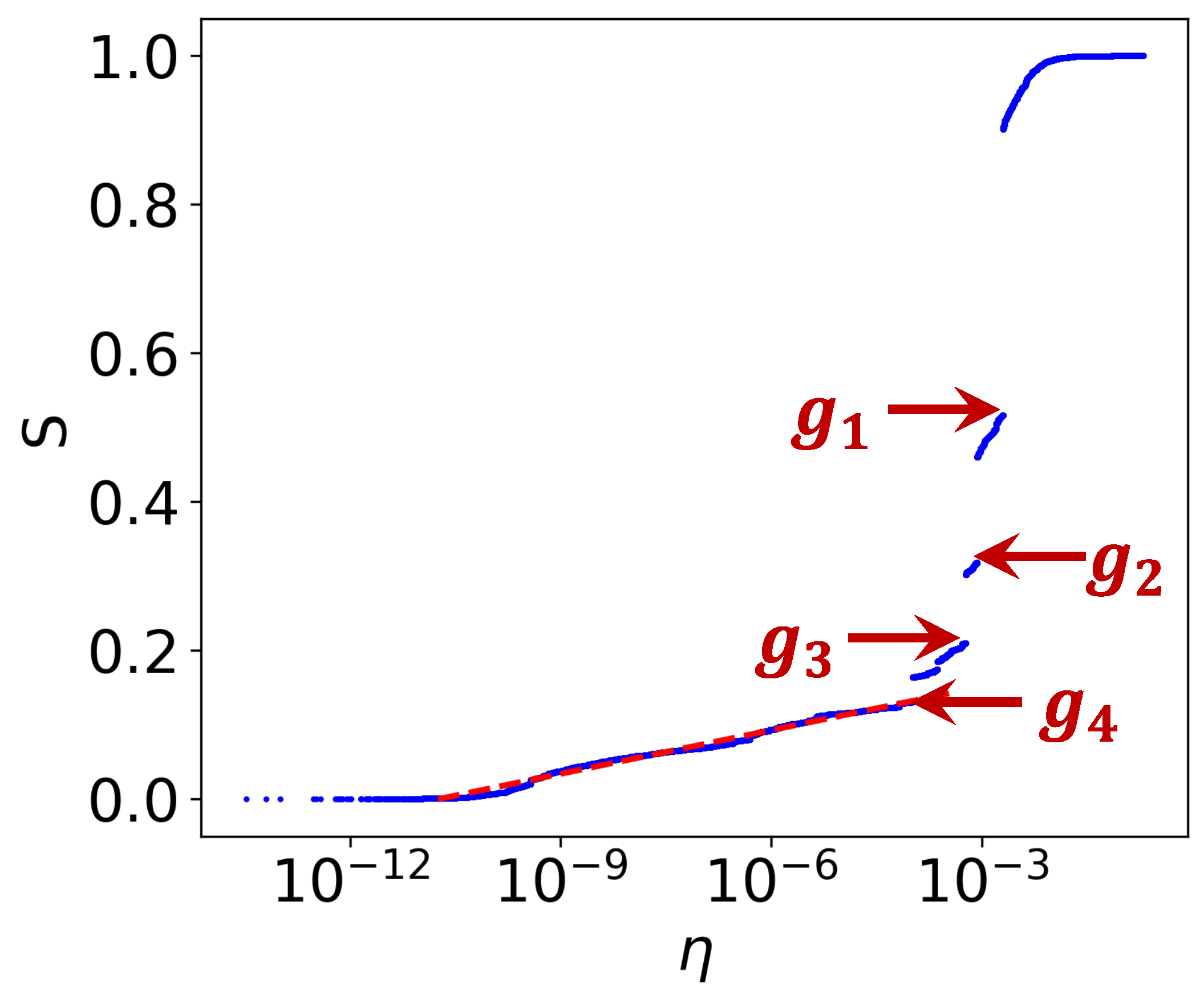
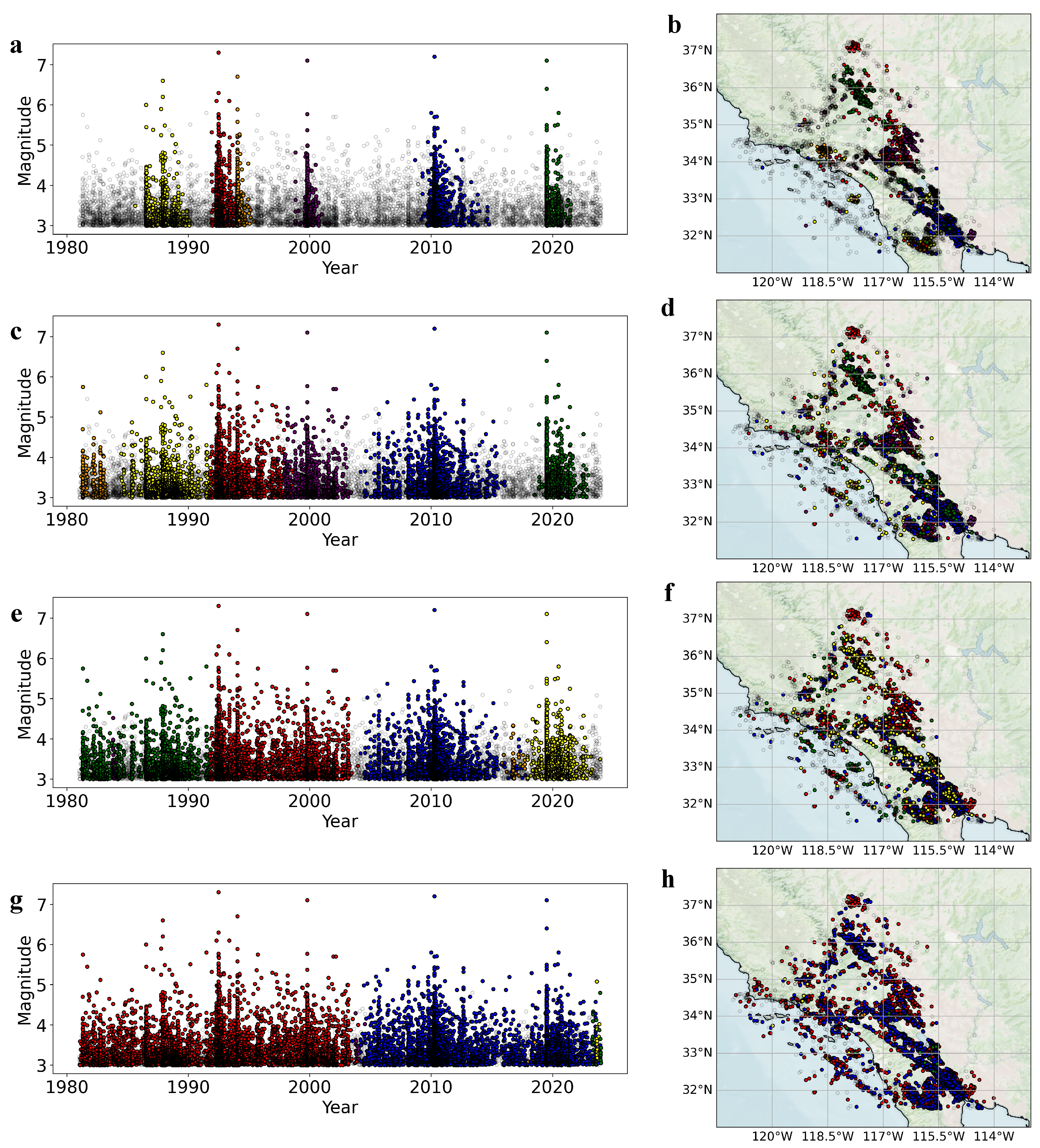
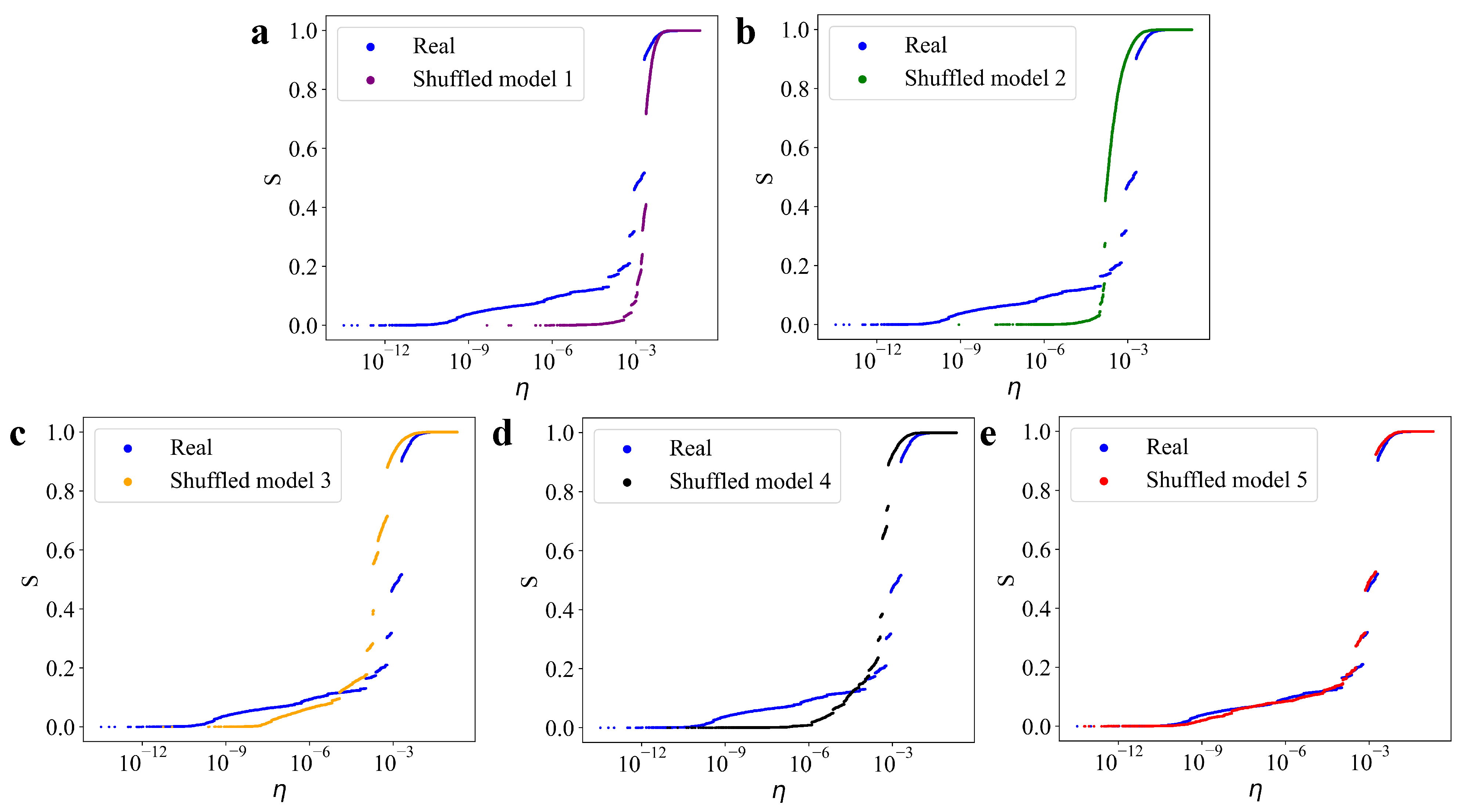
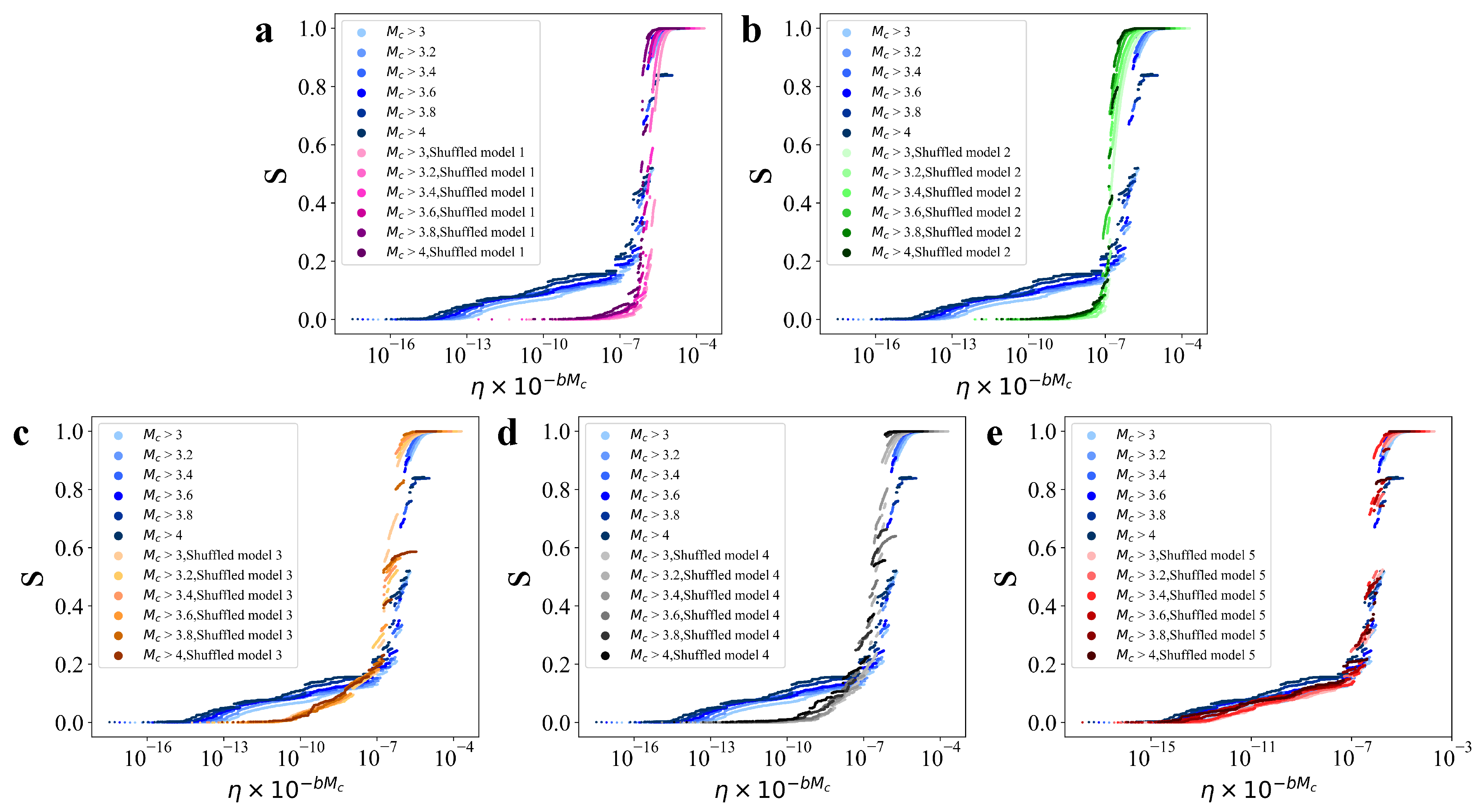
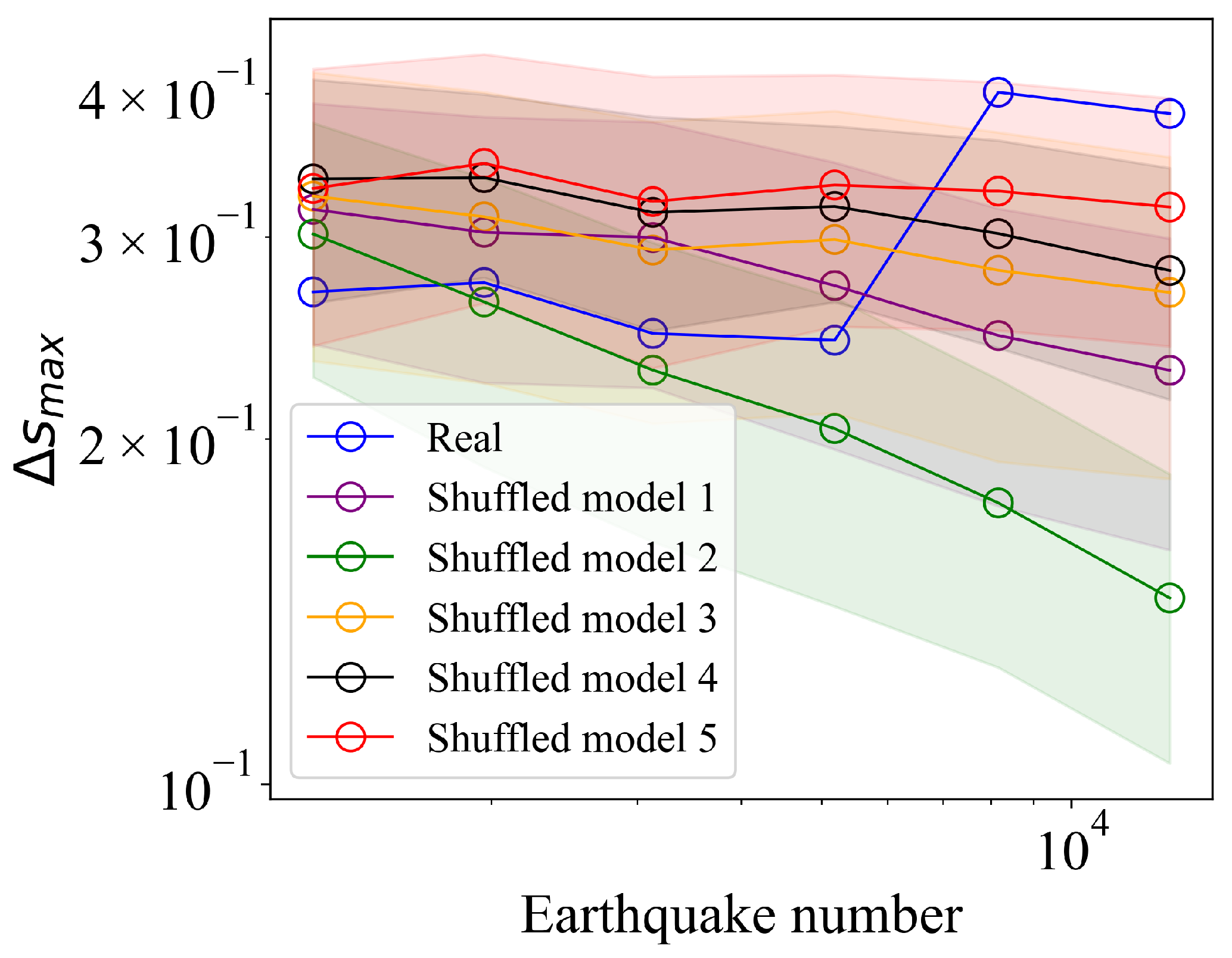
Disclaimer/Publisher’s Note: The statements, opinions and data contained in all publications are solely those of the individual author(s) and contributor(s) and not of MDPI and/or the editor(s). MDPI and/or the editor(s) disclaim responsibility for any injury to people or property resulting from any ideas, methods, instructions or products referred to in the content. |
© 2025 by the authors. Licensee MDPI, Basel, Switzerland. This article is an open access article distributed under the terms and conditions of the Creative Commons Attribution (CC BY) license (https://creativecommons.org/licenses/by/4.0/).
Share and Cite
Zhao, Z.; Li, Y.; Zhang, Y. Scaling and Clustering in Southern California Earthquake Sequences: Insights from Percolation Theory. Entropy 2025, 27, 347. https://doi.org/10.3390/e27040347
Zhao Z, Li Y, Zhang Y. Scaling and Clustering in Southern California Earthquake Sequences: Insights from Percolation Theory. Entropy. 2025; 27(4):347. https://doi.org/10.3390/e27040347
Chicago/Turabian StyleZhao, Zaibo, Yaoxi Li, and Yongwen Zhang. 2025. "Scaling and Clustering in Southern California Earthquake Sequences: Insights from Percolation Theory" Entropy 27, no. 4: 347. https://doi.org/10.3390/e27040347
APA StyleZhao, Z., Li, Y., & Zhang, Y. (2025). Scaling and Clustering in Southern California Earthquake Sequences: Insights from Percolation Theory. Entropy, 27(4), 347. https://doi.org/10.3390/e27040347





